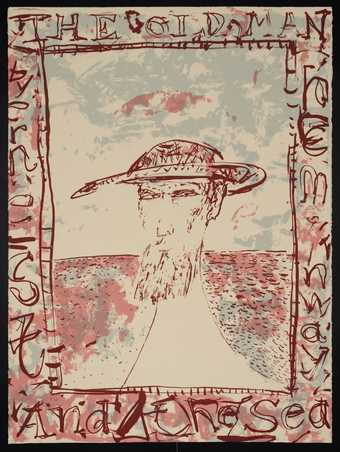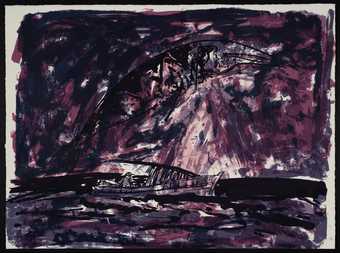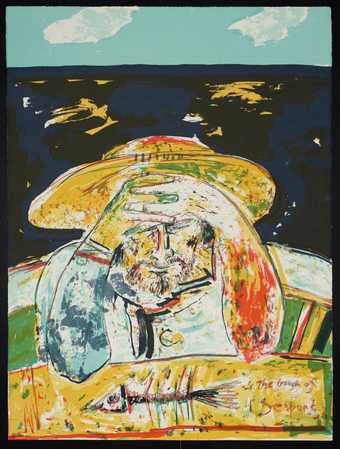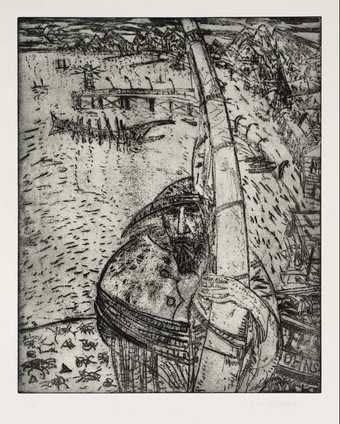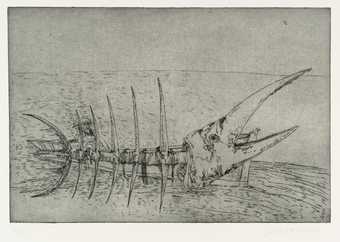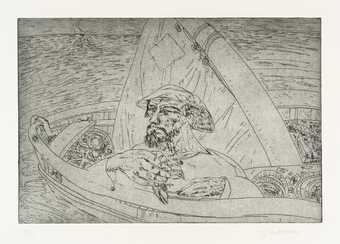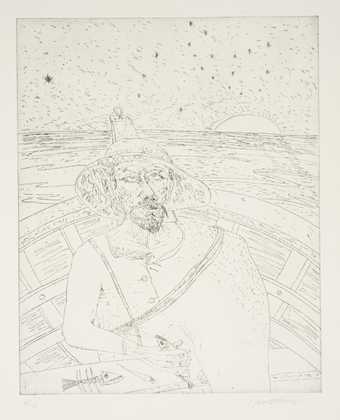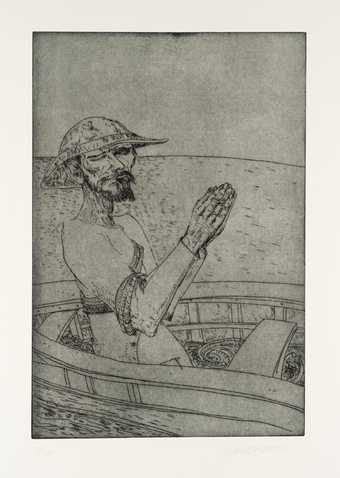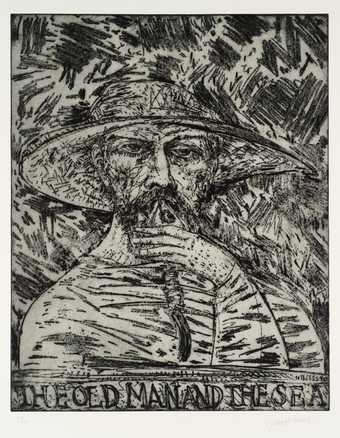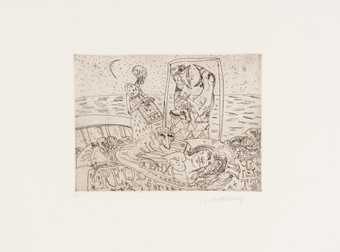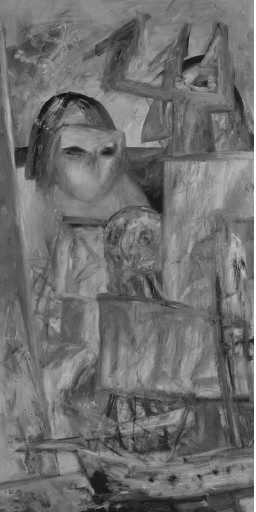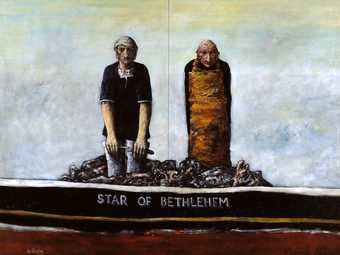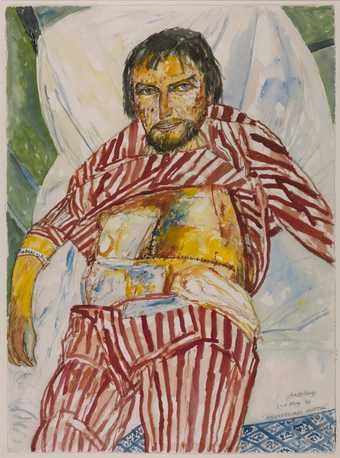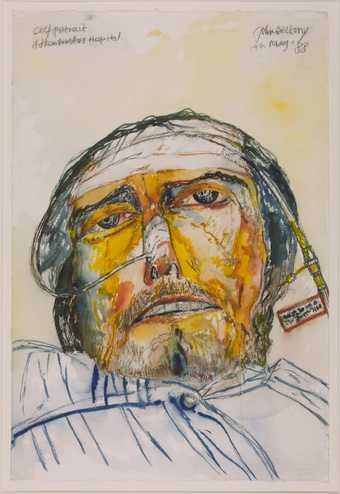
Not on display
- Artist
- John Bellany 1942–2013
- Medium
- Oil paint on canvas
- Dimensions
- Support: 1015 × 761 × 23 mm
frame: 1214 × 957 × 48 mm - Collection
- Tate
- Acquisition
- Presented by the artist in memory of David Brown 2003
- Reference
- T11750
Summary
Born into the Scottish fishing community of Port Seton, on the east coast north of Edinburgh, Bellany made his earliest drawings from careful observation of the small wooden fishing boats used by his father’s generation of fishermen. Dominated by the sea and by a guilt-ridden, unforgiving Calvinist faith, the fishing and boat-building culture of Bellany’s father and both grandfathers has remained a recurrent source of inspiration for him. He studied painting at the Edinburgh College of Art (1960-5) and at the Royal College of Art, London (1965-8). Early contact with the Scottish artist Alan Davie (born 1920), who remains a good friend, and the Scottish poet Hugh MacDiarmid (1892-1978) inspired Bellany to attempt to create a specifically Scottish art. In the early 1960s, when the influence of abstract American art was all-pervasive, Bellany rejected the new fashion as well as the bland classical formalism constituting the dominant mode in Edinburgh at that time and embraced figurative painting engaged with the grand themes of life and death, good and evil. Earlier works are inhabited by a dark medieval moodiness which develops, as his palette brightens, to a vivid expressionism reminiscent of the later paintings of Edvard Munch (1863-1944). Bellany consciously allied himself with the northern tradition of Hieronymous Bosch (c.1450-1516) and Pieter Brueghel (1520-69) and later with the Nordic tradition of soulful expressionist humanism such as that of the German Expressionists Max Beckmann (1884-1950) and Oskar Kokoshka (1886-1980). Following a life-altering visit to Buchenwald in the late 1960s, Bellany’s work became extremely raw and, at points, almost despairing, as he repainted his autobiography, often as a series of epic and frequently nightmarish sea voyages populated by the artist and those closest to him. Here the main protagonists were often portrayed as anthropomorphic animals or birds, suggestive of classical or Celtic mythology.
The recent painting Homage to David B shows a blonde-bearded fisherman sitting in a small wooden rowing boat bearing the name David B on its side. The same colour as the sea, the fisherman’s eyes are on a level with the horizon line and stare calmly out into the distance beyond the painting. The fisherman’s left hand rests on an oar which extends beyond the picture frame. In the foreground, a large fish emerges from the water, attached to the boat by three red ribbon-like filaments. Although its mouth is open displaying teeth, the fish wears a resigned expression on its quasi-human face. The painting’s mood is calm and resolved; the fisherman appears to be in a state of some kind of spiritual communion. The imagery evokes the Biblical story narrated in Matthew 4 v.17-23 when Christ called on his fishermen disciples to join him as ‘fishers of men’.
The David B referred to in the painting is the late Dr David Brown (1925-2002), in whose memory the artist made the painting. David Brown was a curator at the Tate Gallery from 1974-84. Before this he worked as assistant to the director at the Scottish National Gallery of Modern Art in Edinburgh and retained a special affection for Scottish art and artists. Brown also advised Southampton Art Gallery and met Bellany in the late 1970s. It was at this point that he encouraged the then director of the Tate, Sir Norman Reid to visit Bellany’s studio together with Richard Morphet, Deputy Keeper of the Modern Collection. The purchase that resulted was Celtic Marriage, 1978 (T02333) followed by Star of Bethlehem, 1966 (T02336), presented to the Tate by the Contemporary Art Society. Tate also owns three prints from the 1970s and The Old Man and the Sea, 1986-7 (P20063-P20076). Bellany painted Brown’s portrait in 1985, the year after Brown retired from Tate (Dr David Brown 1985, Maxi/Hudson Collection).
Further reading:
John McEwen, John Bellany, Edinburgh and London 1994
John Bellany: A Scottish Odyssey, exhibition catalogue, Beaux Arts, London 1998
John Bellany: New Portraits, exhibition catalogue, National Portrait Gallery, London 1985, pp.18 and 30
Elizabeth Manchester
January 2006
Does this text contain inaccurate information or language that you feel we should improve or change? We would like to hear from you.
Explore
- people(22,072)
- body(4,878)
-
- beard(206)
- named individuals(12,887)
-
- Brown, David(1)
- portraits(4,491)
-
- individuals: male(1,841)
- birth to death(1,472)
-
- memorial(307)
- boat, rowing(688)
You might like
-
John Bellany Untitled
1986–7 -
John Bellany Untitled
1986–7 -
John Bellany Untitled
1986–7 -
John Bellany Untitled
1986–7 -
John Bellany Untitled
1986–7 -
John Bellany Untitled
1986–7 -
John Bellany Untitled
1986–7 -
John Bellany Untitled
1986–7 -
John Bellany Untitled
1986–7 -
John Bellany Untitled
1986–7 -
John Bellany Requiem for Juliet
1986 -
John Bellany Celtic Marriage
1978 -
John Bellany Star of Bethlehem
1966 -
John Bellany Self-Portrait
1988 -
John Bellany Self-Portrait
1988

